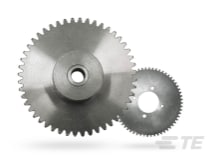-
Overview
Pole Wheel

- Jaquet
A pole wheel on the target shaft is required when using contactless sensors to generate a signal. Often an existing gear wheel can be used but where none is present a special gear, slotted or holed disk would be added. Pole wheels can be ordered with or without a boss, please refer to the datasheet for ordering information.
Product Features
-
Sensor Type : Pole Wheels
-
Pole Wheel Material : Ferromagnetic
-
Pole Wheel Module : 1 – 3


